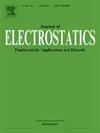Performance analysis of lateral sliding mode triboelectric nanogenerators for self-powered healthcare applications
IF 2.1
4区 工程技术
Q3 ENGINEERING, ELECTRICAL & ELECTRONIC
引用次数: 0
Abstract
In the sphere of healthcare, self-powered sensing and energy collection have been revolutionized by triboelectric nanogenerators. The integration of small-scale energy devices has resulted in significant enhancements to health and quality of life in implanted biomedical electronics. This article specifically addresses planar lateral sliding mode triboelectric nanogenerators. The output performance of an lateral sliding mode can be affected by factors such as the dielectric layer thickness, electrode thickness, dielectric constant, surface area, surface charge density, weight of the structure and other environmental factors. This study analyzes the intrinsic electrical output of the lateral sliding mode, such as the open-circuit voltage, capacitance, short-circuit charge, energy, efficiency and stability with biocompatibility. The results showed that triboelectric nanogenerators with thin dielectric films exhibit higher voltage, charge, and energy than those with thicker dielectric materials. Additionally, the performance of the triboelectric nanogenerators was influenced by maintaining a constant positive layer thickness and varying the negative layer thickness. Moreover, different electronegative films in triboelectric nanogenerators based on dielectric constants produced the best electrical output during relative dielectric constant testing. The lateral sliding mode modeling and simulations were performed using MATLAB software, which was used for the design, material selection, and stationary study of healthcare devices. This work provides a practical framework for utilizing the triboelectric effect in various healthcare equipment to generate energy from low-vibration human movement. The biocompatibility, light weight, and small size of triboelectric nanogenerators make it a promising technology for enhancing life and health in the future.

用于自供电医疗保健应用的横向滑动模式三电纳米发电机的性能分析
在医疗保健领域,摩擦纳米发电机已经彻底改变了自供电传感和能量收集。小型能源装置的集成大大提高了植入生物医学电子设备的健康和生活质量。这篇文章专门讨论平面横向滑动模摩擦纳米发电机。横向滑模的输出性能会受到介电层厚度、电极厚度、介电常数、表面积、表面电荷密度、结构重量等环境因素的影响。本研究分析了横向滑模的本征电输出,如开路电压、电容、短路电荷、能量、效率和生物相容性稳定性。结果表明,与具有较厚介质材料的摩擦纳米发电机相比,具有较薄介质薄膜的摩擦纳米发电机具有更高的电压、电荷和能量。此外,保持恒定的正层厚度和改变负层厚度会影响摩擦电纳米发电机的性能。此外,在相对介电常数测试中,基于介电常数的摩擦纳米发电机中不同的电负性薄膜产生了最佳的电输出。使用MATLAB软件进行横向滑模建模和仿真,该软件用于医疗器械的设计、材料选择和静止研究。这项工作为在各种医疗设备中利用摩擦电效应从低振动人体运动中产生能量提供了一个实用的框架。摩擦电纳米发电机具有生物相容性好、重量轻、体积小等特点,是未来改善生命健康的重要技术。
本文章由计算机程序翻译,如有差异,请以英文原文为准。
求助全文
约1分钟内获得全文
求助全文
来源期刊

Journal of Electrostatics
工程技术-工程:电子与电气
CiteScore
4.00
自引率
11.10%
发文量
81
审稿时长
49 days
期刊介绍:
The Journal of Electrostatics is the leading forum for publishing research findings that advance knowledge in the field of electrostatics. We invite submissions in the following areas:
Electrostatic charge separation processes.
Electrostatic manipulation of particles, droplets, and biological cells.
Electrostatically driven or controlled fluid flow.
Electrostatics in the gas phase.
 求助内容:
求助内容: 应助结果提醒方式:
应助结果提醒方式:


